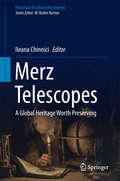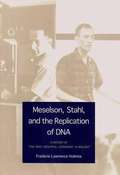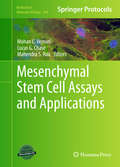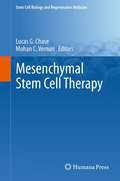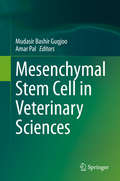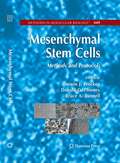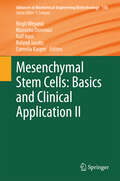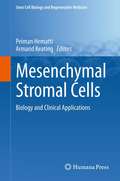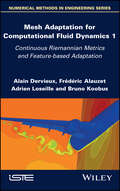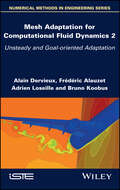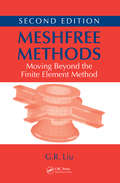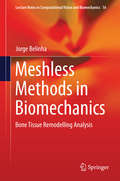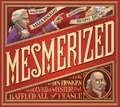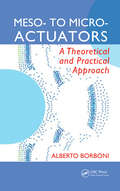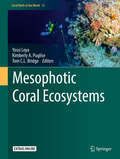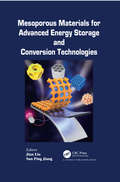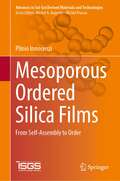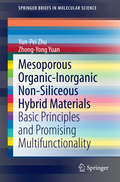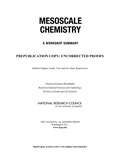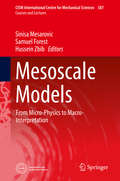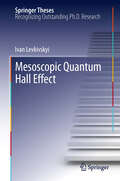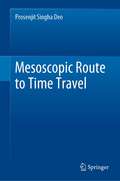- Table View
- List View
Merrill Chemistry
by Jack Price Robert C. Smoot Richard G. Smith Tom RussoEach chapter of Merrill CHEMISTRY is organized to keep you centered on the topic at hand. The next few pages describe the many features of this book that will help you understand the exciting world of chemistry.
Merrill Physical Science
by Marilyn Thompson Richard G. Smith Charles W. MclaughlinMerrill Physical Science will help you understand science principles and recognize their applications to everyday life.
Merz Telescopes: A global heritage worth preserving (Historical & Cultural Astronomy)
by Ileana ChinniciThis book comprisesa fascinating collection of contributions on the Merz telescopes in Italy that collectivelyoffer the first survey on historical large refracting telescopes in the country,drawing on original documents and photographs. It opens with a generalintroduction on the importance of Merz telescopes in the history of astronomyand analyses of the local and international contexts in which the telescopes weremade. After examination of an example of the interaction between the maker andthe astronomer in the construction and maintenance of these refractors, thehistory of the Merz telescopes at the main Italian observatories in the nineteenthcentury is described in detail. Expert testimony is also provided on how thesetelescopes were successfully used until the second half of the twentieth centuryfor research purposes, thus proving their excellent optical qualities.
Meselson, Stahl, and the Replication of DNA: A History of "the Most Beautiful Experiment in Biology"
by Frederic Lawrence HolmesIn 1957 two young scientists at the California Institute of Technology performed an experiment that provided convincing evidence that DNA replicates in the manner predicted by the model of the double helix proposed four years earlier by James Watson and Francis Crick.
Mesenchymal Stem Cell Assays and Applications
by Mahendra S. Rao Mohan C Vemuri Lucas G. ChaseMesenchymal Stem Cells have seen an unprecedented level of interest in the last decade, primarily due to their relative ease of isolation, the large numbers of cells present in the adult, and the ability to propagate these cells in culture. In Mesenchymal Stem Cell Assays and Applications, expert researchers from across the globe explore the latest techniques to propagate, characterize, and engineer this special cell type. Chapters outline a set of protocols and assays used by leading investigators in the field, providing standards that can be applied by all researchers to the population of cells used in their experiments. Composed in the highly successful Methods in Molecular BiologyTM series format, each chapter contains a brief introduction, step-by-step methods, a list of necessary materials, and a Notes section which shares tips on troubleshooting and avoiding known pitfalls. Ground-breaking and current, Mesenchymal Stem Cell Assays and Applications is a necessary handbook for all researchers working with this ambiguous population of cells.
Mesenchymal Stem Cell Therapy
by Mohan C Vemuri Lucas G. ChaseOver the past decade, significant efforts have been made to develop stem cell-based therapies for difficult to treat diseases. Multipotent mesenchymal stromal cells, also referred to as mesenchymal stem cells (MSCs), appear to hold great promise in regards to a regenerative cell-based therapy for the treatment of these diseases. Currently, more than 200 clinical trials are underway worldwide exploring the use of MSCs for the treatment of a wide range of disorders including bone, cartilage and tendon damage, myocardial infarction, graft-versus-host disease, Crohn's disease, diabetes, multiple sclerosis, critical limb ischemia and many others. MSCs were first identified by Friendenstein and colleagues as an adherent stromal cell population within the bone marrow with the ability to form clonogenic colonies in vitro. In regards to the basic biology associated with MSCs, there has been tremendous progress towards understanding this cell population's phenotype and function from a range of tissue sources. Despite enormous progress and an overall increased understanding of MSCs at the molecular and cellular level, several critical questions remain to be answered in regards to the use of these cells in therapeutic applications. Clinically, both autologous and allogenic approaches for the transplantation of MSCs are being explored. Several of the processing steps needed for the clinical application of MSCs, including isolation from various tissues, scalable in vitro expansion, cell banking, dose preparation, quality control parameters, delivery methods and numerous others are being extensively studied. Despite a significant number of ongoing clinical trials, none of the current therapeutic approaches have, at this point, become a standard of care treatment. Although exceptionally promising, the clinical translation of MSC-based therapies is still a work in progress. The extensive number of ongoing clinical trials is expected to provide a clearer path forward for the realization and implementation of MSCs in regenerative medicine. Towards this end, reviews of current clinical trial results and discussions of relevant topics association with the clinical application of MSCs are compiled in this book from some of the leading researchers in this exciting and rapidly advancing field. Although not absolutely all-inclusive, we hope the chapters within this book can promote and enable a better understanding of the translation of MSCs from bench-to-bedside and inspire researchers to further explore this promising and quickly evolving field.
Mesenchymal Stem Cell in Veterinary Sciences
by Mudasir Bashir Gugjoo Amar PalThis book focuses on mesenchymal stem cells (MSCs) of animal origin, including their isolation, characterization, and clinical applications. After briefly discussing the historical development of the field of stem cell research, it describes the basic properties and nature of stem cells particularly in relation to MSCs. In turn, it reviews materials and methods used to isolate MSCs from various sources, culture expansion, characterization and long-term storage. It also explores the therapeutic efficacy, immunomodulation and anti-inflammatory, and differentiation properties of MSCs. Importantly, the book discusses the applications of genetic engineering to enhance the efficacy and potential of MSCs in regenerative medicine. The book largely addresses the potential applications of mesenchymal stem cells in therapies for important species of domesticated animals including sheep, goats, cattle, buffalo, cats, dogs and horses. Finally, the book presents an abridgement of challenges and future prospects of stem cell research and application in medicine, in general and veterinary sciences, in particular.
Mesenchymal Stem Cells
by Darwin J. Prockop Bruce A. Bunnell Donald G. PhinneyFor over forty years, mesenchymal stem cells (MSCs) have been scrutinized and studied, garnering much attention due to their broad therapeutic efficacy. In this essential book, leaders in the field were assembled to contribute detailed methodologies for the isolation and characterization of human and rodent MSCs. Cutting edge and easy to use, this book is the perfect resource for scientists attempting to pursue this important and ever-developing field of research.
Mesenchymal Stem Cells - Basics and Clinical Application I
by Birgit Weyand Ralf Hass Roland Jacobs Massimo Dominici Cornelia KasperProspective Isolation and Characterization of Human Bone Marrow-Derived MSCs, by A. Harichandan, K. Sivasubramaniyan, H.-J. Bühring Urine as a Source of Stem Cells, by Christina Benda, Ting Zhou, Xianming Wang, Weihua Tian, Johannes Grillari, Hung-Fat Tse, Regina Grillari-Voglauer, Duanqing Pei, Miguel A. Esteban Expansion of Mesenchymal Stem/Stromal Cells under Xenogenic-Free Culture Conditions, by Sven Kinzebach, Karen Bieback Adipose-Derived Mesenchymal Stem Cells: Biology and Potential Applications, by Danielle Minteer, Kacey G Marra, J Peter Rubin Potential for Osteogenic and Chondrogenic Differentiation of MSC, by Antonina Lavrentieva, Tim Hatlapatka, Anne Neumann, Birgit Weyand, Cornelia Kasper Potential for Neural Differentiation of Mesenchymal Stem Cells, by Letizia Ferroni, Chiara Gardin, Ilaria Tocco, Roberta Epis, Alessandro Casadei, Vincenzo Vindigni, Giuseppe Mucci, Barbara Zavan Migratory Properties of Mesenchymal Stem Cells, by Thomas Dittmar, Frank Entschladen Dissecting Paracrine Effectors for Mesenchymal Stem Cells, by Stefania Bruno, Federica Collino, Ciro Tetta, Giovanni Camussi Proteomics Approaches in the Identification of Molecular Signatures of Mesenchymal Stem Cells, by Yin Xiao, Jiezhong Chen Does the Adult Stroma Contain Stem Cells?, by Richard Schäfer
Mesenchymal Stromal Cells
by Armand Keating Peiman HemattiMesenchymal Stromal Cell (MSC) biology has been studied for more than 4 decades and the cells have been investigated for potential clinical applications for more than 15 years. Progress has become exponential over the past decade due mainly to the broad therapeutic potential of these cells. However, MSC studies have also been subject to controversy and increasing scrutiny as new mechanisms of action are reported and ever-expanding therapeutic applications pursued. In this book, leading authorities from all over the world, who are actively involved in this field, provide state-of-the-art knowledge of the basic biology, translational requirements and latest clinical experience with MSCs. This cutting edge book is the ideal resource for scientists and clinicians interested in pursuing an important and rapidly developing field of research that will eventually help patients and address urgent unmet medical needs. Features include: Coverage of the biology of MSCs, latest understanding of mechanisms of action, and role in tissue homeostasis and regenerationIdentifying the potential of MSCs in proceeding from bench to bedside from regulatory , GMP production, ethical and safety aspects Critical analysis of clinical studies and the potential of MSCs to treat a wide variety of human diseases and tissues.
Mesh Adaptation for Computational Fluid Dynamics, Volume 1: Continuous Riemannian Metrics and Feature-based Adaptation
by Frederic Alauzet Adrien Loseille Alain Dervieux Bruno KoobusSimulation technology, and computational fluid dynamics (CFD) in particular, is essential in the search for solutions to the modern challenges faced by humanity. Revolutions in CFD over the last decade include the use of unstructured meshes, permitting the modeling of any 3D geometry. New frontiers point to mesh adaptation, allowing not only seamless meshing (for the engineer) but also simulation certification for safer products and risk prediction.Mesh Adaptation for Computational Dynamics 1 is the first of two volumes and introduces basic methods such as feature-based and multiscale adaptation for steady models. Also covered is the continuous Riemannian metrics formulation which models the optimally adapted mesh problem into a pure partial differential statement. A number of mesh adaptative methods are defined based on a particular feature of the simulation solution.This book will be useful to anybody interested in mesh adaptation pertaining to CFD, especially researchers, teachers and students.
Mesh Adaptation for Computational Fluid Dynamics, Volume 2: Unsteady and Goal-oriented Adaptation
by Frederic Alauzet Adrien Loseille Alain Dervieux Bruno KoobusSimulation technology, and computational fluid dynamics (CFD) in particular, is essential in the search for solutions to the modern challenges faced by humanity. Revolutions in CFD over the last decade include the use of unstructured meshes, permitting the modeling of any 3D geometry. New frontiers point to mesh adaptation, allowing not only seamless meshing (for the engineer) but also simulation certification for safer products and risk prediction.Mesh Adaptation for Computational Dynamics 2 is the second of two volumes and introduces topics including optimal control formulation, minimizing a goal function, and extending the steady algorithm to unsteady physics. Also covered are multi-rate strategies, steady inviscid flows in aeronautics and an extension to viscous flows.This book will be useful to anybody interested in mesh adaptation pertaining to CFD, especially researchers, teachers and students.
Meshfree Methods: Moving Beyond the Finite Element Method, Second Edition
by G.R. LiuUnderstand How to Use and Develop Meshfree TechniquesAn Update of a Groundbreaking WorkReflecting the significant advances made in the field since the publication of its predecessor, Meshfree Methods: Moving Beyond the Finite Element Method, Second Edition systematically covers the most widely used meshfree methods. With 70% new material, this edit
Meshless Methods in Biomechanics
by Jorge BelinhaThis book presents the complete formulation of a new advanced discretization meshless technique: the Natural Neighbour Radial Point Interpolation Method (NNRPIM). In addition, two of the most popular meshless methods, the EFGM and the RPIM, are fully presented. Being a truly meshless method, the major advantages of the NNRPIM over the FEM and other meshless methods, are the remeshing flexibility and the higher accuracy of the obtained variable field. Using the natural neighbour concept, the NNRPIM permits to determine organically the influence-domain, resembling the cellulae natural behaviour. This innovation permits the analysis of convex boundaries and extremely irregular meshes, which is an advantage in the biomechanical analysis, with no extra computational effort associated. This volume shows how to extend the NNRPIM to the bone tissue remodelling analysis, expecting to contribute with new numerical tools and strategies in order to permit a more efficient numerical biomechanical analysis.
Mesmerized: How Ben Franklin Solved A Mystery That Baffled All Of France
by Mara Rockliff Iacopo BrunoDiscover how Benjamin Franklin’s scientific method challenged a certain Dr. Mesmer’s mysterious powers in a whimsical look at a true moment in history. The day Ben Franklin first set foot in Paris, France, he found the city all abuzz. Everyone was talking about something new—remarkable, thrilling, and strange. Something called... Science! But soon the straightforward American inventor Benjamin Franklin is upstaged by a compelling and enigmatic figure: Dr. Mesmer. In elaborately staged shows, Mesmer, wearing a fancy coat of purple silk and carrying an iron wand, convinces the people of Paris that he controls a magic force that can make water taste like a hundred different things, cure illness, and control thoughts! But Ben Franklin is not convinced. Will his practical approach of observing, hypothesizing, and testing get to the bottom of the mysterious Mesmer’s tricks? A rip-roaring, lavishly illustrated peek into a fascinating moment in history shows the development and practice of the scientific method—and reveals the amazing power of the human mind.
Meso- to Micro- Actuators: A Theoretical and Practical Approach
by Alberto BorboniExploring the design and use of micro- and meso-actuators, this book begins with theory and a general synopsis of the state-of-the-art in theoretical research. It discusses how to employ modern approaches in research and design activity, then presents a systematic list of already available products and details their potential for use. Design possib
Mesophotic Coral Ecosystems (Coral Reefs of the World #12)
by Yossi Loya Kimberly A. Puglise Tom C.L. BridgeThis book summarizes what is known about mesophotic coral ecosystems (MCEs) geographically and by major taxa. MCEs are characterized by light-dependent corals and associated communities typically found at depths ranging from 30-40 m. and extending to over 150 m. in tropical and subtropical ecosystems. They are populated with organisms typically associated with shallow coral reefs, such as macroalgae, corals, sponges, and fishes, as well as specialist species unique to mesophotic depths. During the past decade, there has been an increasing scientific and management interest in MCEs expressed by the exponential increase in the number of publications studying this unique environment. Despite their close proximity to well-studied shallow reefs, and the growing evidence of their importance, our scientific knowledge of MCEs is still in its early stages. The topics covered in the book include: regional variation in MCEs; similarities and differences between mesophotic and shallow reef taxa, biotic and abiotic conditions, biodiversity, ecology, geomorphology, and geology; potential connectivity between MCEs and shallow reefs; MCE disturbances, conservation, and management challenges; and new technologies, key research questions/knowledge gaps, priorities, and future directions in MCE research.
Mesoporous Materials for Advanced Energy Storage and Conversion Technologies
by San Ping Jiang Jian LiuInnovation through specific and rational design and functionalization has led to the development of a wide range of mesoporous materials with varying morphologies (hexagonal, cubic, rod-like), structures (silicates, carbons, metal oxides), and unique functionalities (doping, acid functionalization) that currently makes this field one of the most exciting in materials science and energy applications. This book focuses primarily on the rapid progress in their application in energy conversion and storage technologies, including supercapacitor, Li-ion battery, fuel cells, solar cells, and photocatalysis (water splitting) and will serve as a valuable reference for researchers in the field
Mesoporous Ordered Silica Films: From Self-Assembly to Order (Advances in Sol-Gel Derived Materials and Technologies)
by Plinio InnocenziThis book introduces the fascinating world of self-assembly in mesoporous ordered silica films. Beginning from a single droplet, it guides the reader, in a step-by-step learning process, how to obtain and control ordered porous mesophases in thin films by varying only the precursor chemistry and the process. It explains, in great detail, how order control is achieved through chemical design and post-deposition processing, the latter of which is a unique property in materials science. The book places a special focus on silica, whose particularly complex chemistry enables order control over a range of different length scales. This book is suitable for students and researchers in the fields of sol-gel or colloidal chemistry and interested in the topics of self-assembly and mesoporous phases.
Mesoporous Organic-Inorganic Non-Siliceous Hybrid Materials
by Yun-Pei Zhu Zhong-Yong YuanThis book provides extensive information on organic-inorganic hybrid materials with controllable compositions and structures developed over the past few decades, including metal sulfonates, carboxylates, phosphonates, metal-organic frameworks (MOFs), etc. A variety of judicious strategies for optimizing mesoporosity are also introduced, aiming at realizing the corresponding superiorities of hybrid frameworks in practical applications at the nano-/meso-scale. The morphological design and modification methods are also described in detail, which extend the potential application range of hybrid materials from traditional areas to high-tech fields. The book offers an ideal reference work for readers in the fields of chemistry, chemical engineering, physics, materials and biology, especially those who are interested in porous hybrid materials. Zhong-Yong Yuan is a Chair Professor at the College of Chemistry, Nankai University, China.
Mesoscale Chemistry: A Workshop Report
by Kathryn HughesIn the last few decades great strides have been made in chemistry at the nanoscale, where the atomic granularity of matter and the exact positions of individual atoms are key determinants of structure and dynamics. Less attention, however, has been paid to the mesoscale - it is at this scale, in the range extending from large molecules (10 nm) through viruses to eukaryotic cells (10 microns), where interesting ensemble effects and the functionality that is critical to macroscopic phenomenon begins to manifest itself and cannot be described by laws on the scale of atoms and molecules alone. To further explore how knowledge about mesoscale phenomena can impact chemical research and development activities and vice versa, the Chemical Sciences Roundtable of the National Research Council convened a workshop on mesoscale chemistry in November 2014. With a focus on the research on chemical phenomena at the mesoscale, participants examined the opportunities that utilizing those behaviors can have for developing new catalysts, adding new functionality to materials, and increasing our understanding of biological and interfacial systems. The workshop also highlighted some of the challenges for analysis and description of mesoscale structures. This report summarizes the presentations and discussion of the workshop.
Mesoscale Models: From Micro-Physics to Macro-Interpretation (CISM International Centre for Mechanical Sciences #587)
by Samuel Forest Sinisa Mesarovic Hussein ZbibThe book helps to answer the following questions: How far have the understanding and mesoscale modeling advanced in recent decades, what are the key open questions that require further research and what are the mathematical and physical requirements for a mesoscale model intended to provide either insight or a predictive engineering tool? It is addressed to young researchers including doctoral students, postdocs and early career faculty,
Mesoscopic Quantum Hall Effect
by Ivan LevkivskyiIn recent years, remarkable progress in the fabrication of novel mesoscopic devices has produced a revival of interest in quantum Hall physics. New types of measurements, more precise and efficient than ever, have made it possible to focus closely on the electronic properties of quantum Hall edge states. This is achieved by applying charge and heat currents at mesoscopic length scales, attaching metallic gates and Ohmic contacts, and splitting edge channels with the help of quantum point contacts. The experiments reveal fascinating new phenomena, such as the interference, statistics, and topological phase shifts of fractionally charged quasi-particles, strong interaction and correlation effects, and phase transitions induced by non-Gaussian fluctuations. The thesis discusses some puzzling results of these experiments and presents a coherent picture of mesoscopic effects in quantum Hall systems, which accounts for integer and fractional filling factors and ranges from microscopic theory to effective models, and covers both equilibrium and non-equilibrium phenomena.
Mesoscopic Route to Time Travel
by Prosenjit Singha DeoThis book gives a general introduction to theoretically understand thermodynamic properties and response to applied fields of mesoscopic systems that closely relate to experiments. The book clarifies many conceptual and practical problems associated with the Larmor clock and thus makes it a viable approach to study these properties. The book is written pedagogically so that a graduate or undergraduate student can follow it. This book also opens up new research areas related to the unification of classical and quantum theories and the meaning of time. It provides a scientific mechanism for time travel which is of immense fascination to science as well as society. It is known that developments in mesoscopic physics can lead to downscaling of device sizes. So, new or experienced researchers can have a quick introduction to various areas in which they might contribute in the future. This book is expected to be a valuable addition to the subject of mesoscopic physics.
Mesoscopic Theories of Heat Transport in Nanosystems
by David Jou Antonio Sellitto Vito Antonio CimmelliThis book presents generalized heat conduction laws which, from a mesoscopic perspective, are relevant to new applications (especially in nanoscale heat transfer, nanoscale thermoelectric phenomena, and in diffusive-to-ballistic regime) and at the same time keep up with the pace of current microscopic research. The equations presented in the book are compatible with generalized formulations of nonequilibrium thermodynamics, going beyond the local-equilibrium. The book includes six main chapters, together with apreface and a final section devoted to the future perspectives, as well as an extensive bibliography.


